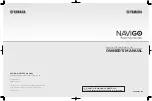
Operating instructions SPEEDY 4all & 4you & 4teen
16
Figure 15: Short inlet with M6 screw screwed in
(outside the frame for better illustration)
3. Remove the three fixing screws (AF 5 mm)
on both wheel plates.
Figure 16: M6 fixing screws
4. Now set the wheel plates at the desired
tipping position on both sides of the frame.
If you have short inlets in the frame, using
the long M6 screws that you have
previously screwed into the thread from
behind, you have to position this accurately
behind the wheel plates so that the tipping
point positions in the frame and thread rest
accurately against one another in the
frame and thread.
The long inlets do not have to be moved.
5. Then fix both wheel plates again, each
with three M6 fixing screws and tighten
these slightly (2 Nm).
6. With long inlets in the frame, now you can
remove the additional fixing screws again
(see step 2).
If you have short inlets in the frame, now
you can remove the long M6 screws from
the threads of the inlets and reinsert the
tube plugs a the ends of the frame.
7. Position the aluminium locking nuts back
onto the drive wheel bearings in such a
manner that these rest slightly against the
position gate and then set the drive wheel
track correctly (see chapter 21.2).
8. Now tighten the respective three M6 fixing
screws to the wheel plates to 7 Nm.
After each change to the tipping point:
the wheel track of the drive wheels must
be checked and readjusted if necessary
(see chapter 21.2).
the caster wheel axle must be readjusted
(see chapter 22.4).
the brakes must be readjusted (see
chapter 25).
Extreme settings, such as drive wheels
mounted far to the front is only permitted for
users with advanced wheelchair skills that are
able to exercise an active weight shift to the
front.
In order to minimise the risk of tipping to
the rear, we recommend the use of anti-tipping
supports, even with anti-tipping device
settings.
18 Back system
Avoid falling into the seating and back
padding as the risk of an adjustment, falling or
a defect is increased significantly.
18.1 Backrest angle
18.1.1 Notes on the sitting posture
For a good sitting posture, we recommend
positioning the backrest vertical to the ground,
where possible.
With low backrest with adaptable belt cover
due to a disability, under certain
circumstances, it may also be a benefit for a
good sitting stability to slightly tilt the backrest
to the front and to slacken the top belt of the
M6 fixing screws
















































